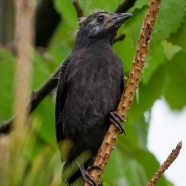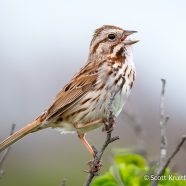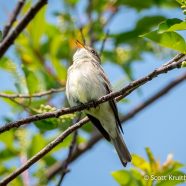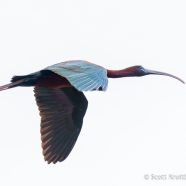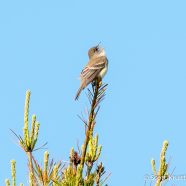Common Grackle Fledgling
This little dinosaur – er, uh…bird – is a Common Grackle (Quiscalus quiscula) fledgling looking for another bite on a recent morning. The hatchlings and fledglings of so many species end up looking like tiny dinosaurs to me in some ways. For some reason the little Willets (Tringa semipalmata), a large shorebird species, always struck me as a dinosaur with a long neck, long legs and barely any wings. Without their flight ability and all of those feathers many species of young birds seem to be a glimpse of the past. Scott Kruitbosch Conservation & Outreach...
Read MoreSinging Song
This can be the quietest time of the season for some Song Sparrows (Melospiza melodia) as they keep their incessant and resonant voices down after having established territory, found a mate, and successfully built a nest. You do not want to advertise quite as much when there are eggs and young to protect, but sometimes you do have to keep an eye on your property and belt out a tune or two.
Read MoreEastern Wood-Pewee
I recently mentioned that we still have flycatchers coming into the region as spring migration wraps up, and even into early June you may find individuals at migratory stopover sites. One such bird was this Eastern Wood-Pewee (Contopus viren), and he provided far better looks here than most do in the depths of the dark forest or higher up in the canopy. Finding him was easy thanks to that “peeeeaaaweeee” call, and he is belting it out in the second photo. Identifying flycatchers by voice makes life so much easier, especially when you cannot always rely on habitat thanks to...
Read MoreGlossy Ibis
This is not a bird you expect to fly by low over your head, nor one you are ready to turn up and shoot…but here is the Glossy Ibis (Plegadis falcinellus), a wader of the Atlantic and Gulf Coasts. The species is actually present on six continents, and because it is a long-legged wading bird found in our coastal marshes it is one of the many species we tally in the Audubon Alliance for Coastal Waterbirds. Protecting their habitat, tracking their populations, and studying where they are and when all helps us learn more now and utilize better conservation management practices later. Scott...
Read MoreWillow Flycatcher
One of our later arriving neotropical migrants, the Willow Flycatcher (Empidonax traillii) seen here was belting out its song on top of a pine. One of the Empidonax flycatchers, they are basically indistinguishable from the Alder Flycatcher by sight, though the other “Empid” species usually have brighter eyerings. Regardless, you should always use your ears first when it comes to these birds! Far too many people attempt to pin down an identification just by staring at photos later on when birds besides the Empidonax flycatchers, like the Eastern Wood-Pewee, Great Crested...
Read More



